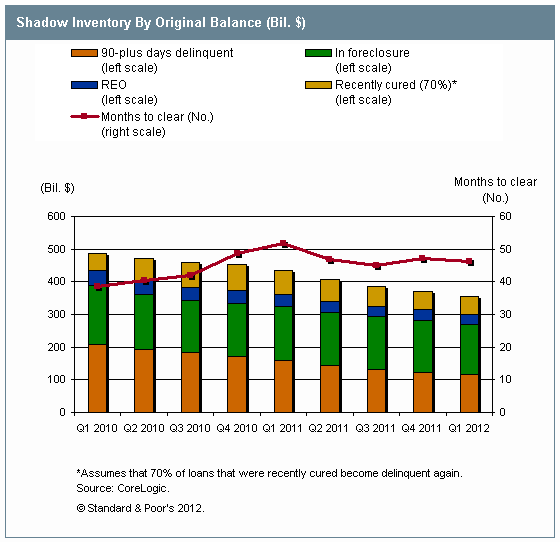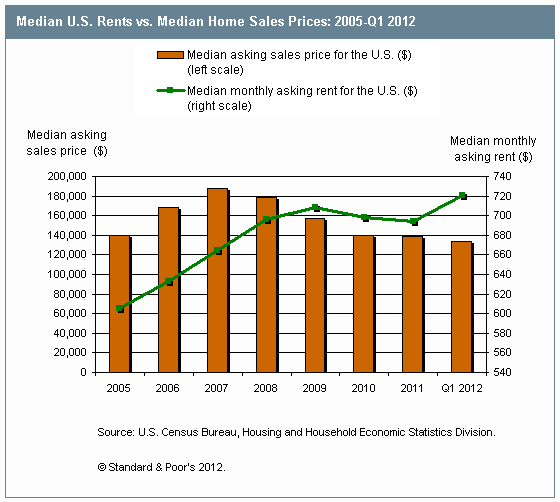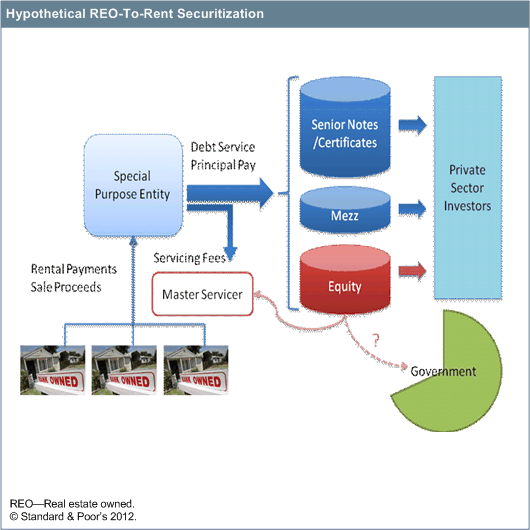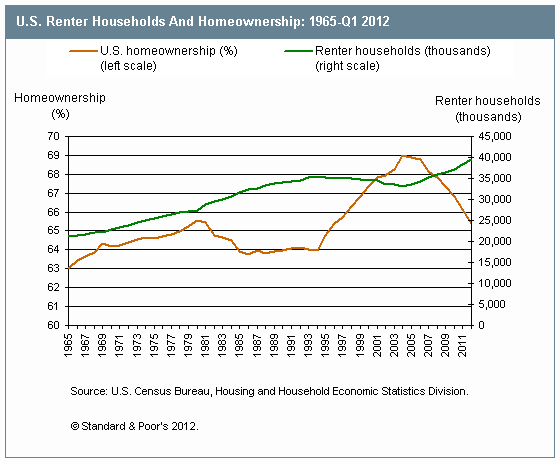The housing market is throwing out mixed signals. The Federal Housing Finance Agency (FHFA) came out this year with a REO-to-rental type program. The initial program was aimed at a small pool of 2,500 properties in eight distressed states targeting shadow inventory. Wait. I thought shadow inventory was no longer a problem? So why is the government actively soliciting bids from large investors, many connected to the same large banks that set the foundation for this financial crisis, in a market where active inventory is incredibly low? This is part of the core mission of the modern day real estate feudal system where even small investors are locked out of the market or pushed to gamble if they want to compete. There is no shortage of investors looking to buy property today with their own money. Just look at the hipster mania here in California. So why try to devise these complicated programs where rents will be securitized for easy selling to Wall Street? If this sounds familiar a similar thing occurred with MBS and even the more toxic CDOs.
REO-to-rental
Contrary to what is being said there is still a good amount of distressed inventory out there:

Source: S&P
This is an interesting way of looking at shadow inventory based on total original loan balance. As of the end of Q1 of 2012 there was over $300 billion in shadow inventory property. This of course is based on conservative estimates since there are many more places 30+ days late. You can see from the chart above that it would take a good amount of time to clear this inventory. Yet the market this year has been moving up steadily in price. Thanks to low inventory and the Fedís massive intervention in lowering interest rates. So why in the world would the government create a shadow market simply to off load these properties to investors with big enough pockets? How well do you think a big bank is going to manage thousands of properties across the country?
It is understandable why this is occurring since Wall Street, the Fed, and banks essentially realize that the government is not going to do anything to stop their massive speculation. The Fed is basically free to do whatever it likes without oversight from our government. In the current market of low yield, this is what they are looking at:

The median asking sales price of a home is now ticking back up but rents are heading to record highs. Why? This is occurring for a variety of reasons:
-1. Bursting of housing bubble pushed multi-family CRE building to new lows
-2. Many are simply unable to buy even in this environment and rental properties are in limited supply
-3. The millions that lost homes through foreclosures ended up as renters
-4. Steady growth of the population
Do not mistake the rise in rents with a rise in household income. What we have occurring is that Americans are seeing their disposable income shrink and more of it going to housing. The rise in rents has caused Wall Street to contemplate the idea of being a landlord. Yet the big mistake with REO-to-rental securitization is the notion that pass-through rates are going to be steady. There is no market history for this here aside from individual landlords and property managers. Yet experience here just like in life can vary greatly.
In the past prior to the 2000s, mortgages were fairly safe bets. Investors could feel safe knowing they would get their money back either through steady payments, refinances, or ultimately a sale. The mortgage market used to be very stable. Yet with rentals you have the following:
-1. Repairs (each time a new tenant comes in, there is undoubtedly repairs)
-2. Vacancies Ė by definition many are only in a home for a short duration
-3. Property management costs Ė donít think that many of these bankers are going to get their hands dirty with the day-to-day management of the home
The rental market is very different here but rising rents are definitely getting the attention of big money. Typically big money flowed into multi-family properties like apartments or condos where economies of scale made it more effective to manage. To manage individual single-family homes is probably something best left to local investors that best understand their local market or those willing to put their own money on the table. Why block out the market to only big banks/big money here?
The REO-to-rental idea
The securitization idea is definitely getting some attention:

This is an interesting breakdown. Who gets the tax benefits here? How do you breakdown maintenance. Who really owns the property here? The idea gets muddied because future rental payments are volatile. Also, are projections going to be for 30 years?
Think of a place like Detroit or Cleveland where the rental market collapsed over the years. Those thinking they can see deep into the future especially with our baby boomer population retiring are going to have to take some wild bets.
Another driving force is that yes, we do have more renters out in the market today:

Nearly 40,000,000 households are renters. The homeownership rate has fallen from 69 percent at the peak back down to nearly 65 percent. These massive intervention programs like the FHA, FHFA REO-to-rental, and FED QE3 are causing bubble like behavior in places like California once again. You hear all this noise that shadow inventory doesnít exist then you have this FHFA program specifically designed to reduce shadow inventory by selling properties to big money.
http://www.doctorhousingbubble.com/r...reet-landlord/
REO-to-rental
Contrary to what is being said there is still a good amount of distressed inventory out there:

Source: S&P
This is an interesting way of looking at shadow inventory based on total original loan balance. As of the end of Q1 of 2012 there was over $300 billion in shadow inventory property. This of course is based on conservative estimates since there are many more places 30+ days late. You can see from the chart above that it would take a good amount of time to clear this inventory. Yet the market this year has been moving up steadily in price. Thanks to low inventory and the Fedís massive intervention in lowering interest rates. So why in the world would the government create a shadow market simply to off load these properties to investors with big enough pockets? How well do you think a big bank is going to manage thousands of properties across the country?
It is understandable why this is occurring since Wall Street, the Fed, and banks essentially realize that the government is not going to do anything to stop their massive speculation. The Fed is basically free to do whatever it likes without oversight from our government. In the current market of low yield, this is what they are looking at:

The median asking sales price of a home is now ticking back up but rents are heading to record highs. Why? This is occurring for a variety of reasons:
-1. Bursting of housing bubble pushed multi-family CRE building to new lows
-2. Many are simply unable to buy even in this environment and rental properties are in limited supply
-3. The millions that lost homes through foreclosures ended up as renters
-4. Steady growth of the population
Do not mistake the rise in rents with a rise in household income. What we have occurring is that Americans are seeing their disposable income shrink and more of it going to housing. The rise in rents has caused Wall Street to contemplate the idea of being a landlord. Yet the big mistake with REO-to-rental securitization is the notion that pass-through rates are going to be steady. There is no market history for this here aside from individual landlords and property managers. Yet experience here just like in life can vary greatly.
In the past prior to the 2000s, mortgages were fairly safe bets. Investors could feel safe knowing they would get their money back either through steady payments, refinances, or ultimately a sale. The mortgage market used to be very stable. Yet with rentals you have the following:
-1. Repairs (each time a new tenant comes in, there is undoubtedly repairs)
-2. Vacancies Ė by definition many are only in a home for a short duration
-3. Property management costs Ė donít think that many of these bankers are going to get their hands dirty with the day-to-day management of the home
The rental market is very different here but rising rents are definitely getting the attention of big money. Typically big money flowed into multi-family properties like apartments or condos where economies of scale made it more effective to manage. To manage individual single-family homes is probably something best left to local investors that best understand their local market or those willing to put their own money on the table. Why block out the market to only big banks/big money here?
The REO-to-rental idea
The securitization idea is definitely getting some attention:

This is an interesting breakdown. Who gets the tax benefits here? How do you breakdown maintenance. Who really owns the property here? The idea gets muddied because future rental payments are volatile. Also, are projections going to be for 30 years?
Think of a place like Detroit or Cleveland where the rental market collapsed over the years. Those thinking they can see deep into the future especially with our baby boomer population retiring are going to have to take some wild bets.
Another driving force is that yes, we do have more renters out in the market today:

Nearly 40,000,000 households are renters. The homeownership rate has fallen from 69 percent at the peak back down to nearly 65 percent. These massive intervention programs like the FHA, FHFA REO-to-rental, and FED QE3 are causing bubble like behavior in places like California once again. You hear all this noise that shadow inventory doesnít exist then you have this FHFA program specifically designed to reduce shadow inventory by selling properties to big money.
http://www.doctorhousingbubble.com/r...reet-landlord/